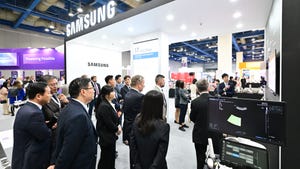
Marvell, unlike the cinematic universe of the same name (minus an "l"), does not feature any hammer-wielding gods or men in iron suits. But the US chipmaker's recent performance has looked just as super-heroic as the movie franchise. Four years ago, Marvell Technology was generating about $600 million in quarterly revenues, with a share price of $17.90. Today, its sales are nudging $1.1 billion a quarter, and its stock has soared to more than $60.
It is on a tear thanks to irrepressible demand for gadgetry and tech, as lifestyles and business affairs continue to shift online. As a designer of the semiconductors used in data centers, 5G basestations, enterprise networks and cars, Marvell finds itself at the epicenter of the action, much like any spandex-wearing superhero when the planet needs saving.
Figure 1: Marvell Technology's share price ($)  Source: Google Finance
Source: Google Finance
An earlier management decision to double down on the data center and carrier markets has clearly paid off. Together, they now account for nearly 60% of Marvell's revenues, up from just 37% in mid-2019. Less volatile than the end-consumer market, these sectors are also characterized by "long product life cycles, sticky design wins and multi-generational engagements," said Marvell CEO Matthew Murphy on a call with analysts.
Marvell, accordingly, watched its sales grow 32% for the recent July-ending quarter, to about $1.08 billion, compared with the year-earlier period. The figures were undoubtedly buoyed by its $10 billion takeover of Inphi, a data center specialist, earlier this year. But Murphy insists much of the improvement was organic. He expects it to continue, as well. For its current third quarter, Marvell is guiding for a 53% increase in revenues, to $1.145 billion.
Components crunch
Everyone believes it. The kryptonite in the mix is the shortage of physical components that is now starving industries from automotive to telecom. In just one sign of that, Japan's Rakuten has had to admit that its network deployment will be delayed by three to six months because of chip shortages. That hold-up will force it to spend more on using rival infrastructure. After a meeting with Rakuten, New Street Research has put these costs at about $180 million a quarter – about twice as much as its previous estimate.
Marvell is relatively powerless when it comes to addressing this semiconductor shortage. Like most US chip companies, it does not make its own components but instead relies mainly on Asian manufacturers such as TSMC. For the most sophisticated chips, using the latest "five-nanometer" technology, there are hardly any alternatives to the Taiwanese firm.
Want to know more about 5G? Check out our dedicated 5G content channel here on Light Reading.
The dependency of Marvell on TSMC is a worry. Asked on the analyst call to explain Marvell's recent successes in the market for application-specific integrated circuits (ASICs), Murphy said they were "all leveraging ... the five-nanometer technology platform that we've introduced in the summer of 2020." If Marvell cannot procure these components from TSMC or South Korea's Samsung – the only other chipmaker that currently appears capable of producing them – it will have to let down its own customers.
In the telecom arena, they include major network vendors such as Nokia and Samsung, both of which Murphy mentioned on the call. "Our wireless revenue growth was driven by ongoing deployments of 5G as well as product ramps at Samsung and Nokia," he said. "Design win progress continues in 5G, and I am pleased to report that we have won a next-generation ASIC design leveraging our five-nanometer technology platform within the radio unit at a key basestation customer."
Even if Marvell can avoid falling short, chip prices are going up. Citing sources close to the matter, the Wall Street Journal this week reported that TSMC is poised to raise the prices of its most advanced chips by about 10% and charge 20% more for less sophisticated components. "I anticipate as we head into calendar 2022 that there will be additional increases across the industry and input costs," said Murphy when quizzed about the pricing environment. "And I'm confident, as part of Marvell, we're able to work with our customers to neutralize that impact."
Unsettling
Still, the likelihood of rising costs will unsettle investors. While sales have risen dramatically at Marvell, losses have also rocketed. For the recent second quarter, it booked a net loss of about $276 million, up from one of $158 million a year earlier. Most of the difference comes down to a sharp increase in research and development expenses, but selling, general and administrative costs were also up.
Another concern for shareholders is the amount of debt that Marvell now carries. After completing the takeover of Inphi, its long-term debts have risen to about $4.7 billion, from just $1 billion at the start of the year. From an investor perspective, this still looks mercifully small next to Marvell's stock market value of about $52 billion.
The market is still betting that rapid growth in sales will carry Marvell into profitable territory, and that executives can manage their way through today's semiconductor crisis. But Marvell's share price was down nearly 4% in pre-market trading on the Nasdaq after the publication of its latest results. A prolonged shortage of components, or one that cuts much deeper than Marvell expects, would be a super-villainous blow.
Related posts:
— Iain Morris, International Editor, Light Reading
Read more about:
AsiaAbout the Author(s)
You May Also Like












